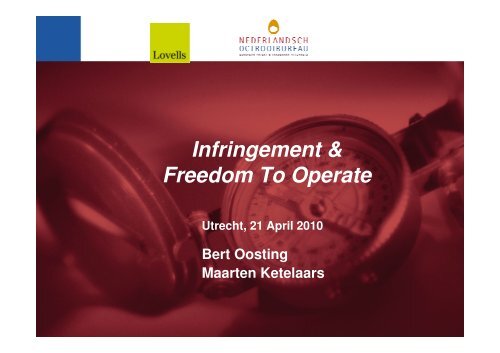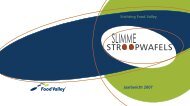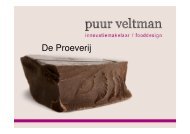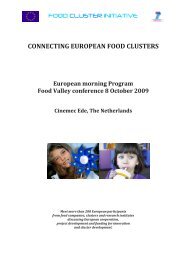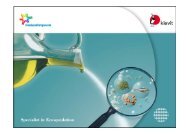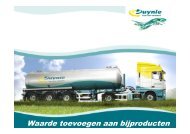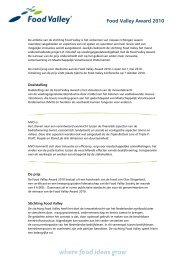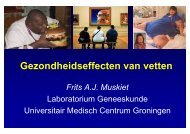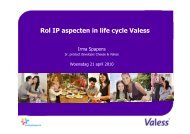Infringement & Freedom To Operate - Food Valley
Infringement & Freedom To Operate - Food Valley
Infringement & Freedom To Operate - Food Valley
You also want an ePaper? Increase the reach of your titles
YUMPU automatically turns print PDFs into web optimized ePapers that Google loves.
<strong>Infringement</strong> &<br />
<strong>Freedom</strong> <strong>To</strong> <strong>Operate</strong><br />
Utrecht, 21 April 2010<br />
Bert Oosting<br />
Maarten Ketelaars
<strong>Infringement</strong><br />
Two sides of IP right<br />
1. Accusation of infringement on 3 rd party’s IP right<br />
2. Owner of IP right notices infringing product/service
<strong>Infringement</strong><br />
<br />
Definition of <strong>Infringement</strong> in Patent Laws:<br />
Right of patent owner :<br />
<br />
<br />
<br />
‘<strong>To</strong> make, use, put on market or resell, hire out or deliver the patented product<br />
or otherwise deal in it, in or for his business, or to offer, import or stock it for any<br />
of those purposes’<br />
‘<strong>To</strong> use the patented process in or for his business or to use, put on the market,<br />
or resell, hire out, deliver the product obtained directly as a result of the use of<br />
the patented process, or deal in any other way, in or for his business, or to offer,<br />
import or stock it for any of those purposes’<br />
Art. 69 EPC + Protocol:<br />
Harmonization in Europe ?
<strong>Infringement</strong><br />
Definition of <strong>Infringement</strong> in Patent Laws (2):<br />
Direct <strong>Infringement</strong>:<br />
Literal <strong>Infringement</strong> or <strong>Infringement</strong> by Equivalence<br />
Indirect (or Induced) <strong>Infringement</strong>:<br />
‘Providing essential elements of patent claim’<br />
additional requirements!
<strong>Infringement</strong> 1 (being accused...)<br />
The IP right mentioned should be valid > check<br />
Register (EPO; NL-Octrooicentrum)<br />
Do the claims as granted actually cover your product?<br />
Special circumstances in your defence:<br />
Prior use right<br />
Patent right exhaustion<br />
‘Gillette’ defence<br />
Data available which is relevant to possible nullity of IP right<br />
Protective letter procedure
<strong>Infringement</strong> 1 (being accused...)<br />
Team of IP Lawyer and Patent Attorney<br />
Each has special knowledge in Procedures / Patent Law<br />
May advise in negotiating deal with IP owner<br />
Management and control of:<br />
<strong>Infringement</strong> procedure at Court<br />
Nullity procedure at Court<br />
Nullity advice from NL Octrooicentrum<br />
Protective letter
<strong>Infringement</strong> 2 (‘get them...’)<br />
<br />
Before taking steps towards a possible infringer:<br />
Make sure your IP right is enforceable<br />
Patent granted/ accelerate grant<br />
Know the relevant prior art (additional search?)<br />
Know the accused infringer’s product in detail:<br />
gather evidence, new possibilities in civil law in Europe for<br />
(descriptive) seizure!<br />
Evidence of infringement in case of process claims (reversal of<br />
burden of proof)
<strong>Infringement</strong> 2 (‘get them...’)<br />
First steps:<br />
Talk/ Warning letter<br />
If no satisfactory result, initiate legal procedure:<br />
In NL:<br />
‘Kort Geding’: quick, cost is limited<br />
‘Bodemprocedure’<br />
Other countries: use local legal knowledge, and<br />
possibilities for co-ordination
Construction and <strong>Infringement</strong><br />
Claim Construction: Limited Harmonisation<br />
Harmonized Approach to Claim Construction (Determination of scope of<br />
protection in Art. 69 European Patent Convention (EPC) and the<br />
Protocol on its Interpretation<br />
Determination of Scope of Protection under Article 69 EPC:<br />
<br />
<br />
<br />
<br />
Art. 69 (1) EPC: scope of protection determined by the claims, description and<br />
drawings used to interpret (the wording of) the claims<br />
Not by a strict, literal meaning of the wording used in the claims<br />
Not by using claims as a guideline and a consideration for the description and<br />
drawings by a person skilled in the art, to determine what the patentee has<br />
contemplated ("Inventive Concept" – Germany / "Essence of the Invention" – The<br />
Netherlands)<br />
But a position between the extremes – fair protection for the patentee (not too<br />
strict/literal meaning of wording of the claims) and a reasonable degree of certainty for<br />
third parties (not too broad/using claims merely as guideline)<br />
General Guidelines only<br />
Determination of infringement under national law (64(3) EPC) – different national<br />
approaches to infringement<br />
Limited harmonisation
Revision of the Protocol on the Interpretation of Art. 69 (EPC)<br />
in EPC 2000 and the Protocol on Interpretation – More<br />
harmonisation?<br />
Equivalents and Prosecution File (statements during<br />
prosecution):<br />
The present provision governing the extent of protection conferred by a<br />
European patent, ie Article 69 EPC and the Protocol on its<br />
interpretation, have turned out not to achieve, to the extent desired, the<br />
goals of ensuring as uniform an application and interpretation as possible.<br />
In particular, this is the case regarding the treatment of so-called<br />
equivalents and the importance of prior statements made by the<br />
applicant for or proprietor of a patent in the application or in the<br />
specification or during prosecution before the EPO or in proceedings<br />
concerning the validity of the patent.<br />
In order to strengthen and clarify the extent of protection under Article 69<br />
EPC, and to contribute to a more uniform court practice in Europe, the<br />
Protocol on its interpretation should be supplemented by a few rules<br />
regarding the significance of equivalents and limiting statements<br />
during prosecution in assessing the extent of protection.
Revision of the Protocol on the Interpretation of Art.<br />
69 EPC in EPC 2000: Equivalents<br />
<br />
Only more harmonisation on equivalents<br />
Article 2 of the Protocol on the Interpretation of Art. 69 EPC:<br />
For the purpose of determining the extent of protection conferred<br />
by a European patent, due account shall be taken of means<br />
which at the time of the alleged infringement are equivalent to<br />
the means specified in the claims.<br />
<br />
No harmonisation on Prosecution File
Application of Art. 69 EPC and the Protocol on its<br />
Interpretation and Claim Construction in The<br />
Netherlands<br />
Art. 69 EPC: scope of protection determined by the claims<br />
(description and drawings serve to interpret the claims)<br />
Always start with the claim language (claims are starting point)<br />
Use description and drawings (and prosecution file) to interpret<br />
claims if claim language is ambiguous<br />
No limitations of scope based on description and drawings when<br />
claim language is clear<br />
Protocol: fair protection of patentee (not too strict/literal<br />
interpretation of wording of the claims) vs. reasonable degree of<br />
certainty for third parties (not too broad: claims (not "essence of<br />
the invention") are starting point,<br />
If this leads to overly broad scope not commensurate to the<br />
invention correction based on description and drawings – Supreme<br />
Court in Lely v. Delaval: "essence of the invention" is not starting<br />
point but still a viewpoint)
Approach to Claim Construction and <strong>Infringement</strong> in<br />
The Netherlands: Equivalents and Prosecution File<br />
<br />
<br />
<br />
<br />
Literal and equivalent infringement/Liko v. Impro:<br />
(i) literal infringement/literal wording (Wortlaut)<br />
(ii) sensible meaning (Wortsinn)<br />
(iii) equivalent infringement)<br />
Equivalents<br />
Function-way-result<br />
<br />
<br />
Insubstantial differences<br />
Inventive equivalents: no infringement<br />
Prosecution File: Ciba Geigy v. Oté Optics<br />
Prosecution file may be used by patentee for interpretation of claims if doubt<br />
ambiguity remains after reading claims and specification<br />
<br />
<br />
Prosecution file used more to disadvantage of patentee because any ambiguity in<br />
claims which is not resolved by specification is for risk of patentee<br />
Abandonment during prosecution only in very clear cases<br />
Prosecution File: Sayer v. Dijkstra<br />
Prosecution file may always be used by third party (e.g. Defendant)<br />
NL Supreme Court explicitly deviates from Courts in UK and Germany
Equivalents in The Netherlands<br />
Function-way-result (mechanical cases)<br />
Substantially different (e.g. inferior) result: no equivalent<br />
infringement<br />
Equivalence easily assumed in case of apparent “design around”<br />
in “way”, but substantially same “function” and “result”<br />
Insubstantial differences (chemical/pharmaceutical/ biotech<br />
cases)<br />
Inventive equivalents<br />
Obvious (“glattes”) equivalence: “equivalence ends where the next<br />
invention begins”<br />
Only if the specific difference between patent and variant is<br />
inventive
The Netherlands vs. UK and Germany<br />
UK:<br />
<br />
<br />
<br />
<br />
Purposive construction (Catnic)<br />
Improver – 3 step purposive construction test<br />
Does difference between the alleged infringing product and product specified in claim have a material<br />
effect on the way invention works? NO?<br />
Would this have been obvious to skilled man? YES?<br />
Would skilled man nevertheless have understood from language of the claim that the patentee<br />
intended to protect only claimed product? NO?: INFRINGEMENT<br />
House of Lords in Amgen v. TKT:<br />
Improver-questions are not rigid checklist “only guidelines more useful in some cases than others”;<br />
Only one compulsory question: what would skilled man have understood the patentee wanted to<br />
cover with the claim language?<br />
No Prosecution File<br />
No protection “outside the claims” – no doctrine of equivalents<br />
Germany:<br />
Literal infringement: Wortlaut and Wortsinn<br />
Custodiol II tripartite equivalence test<br />
Same technical effect (to a practically relevant extent);<br />
Discoverable for skilled man (at the priority date) “without making an invention” (Bratgeschirr: Overall<br />
Discoverability Test);<br />
Variant is in line with inventive concept;<br />
No Prosecution File
<strong>Freedom</strong> <strong>To</strong> <strong>Operate</strong><br />
Usually done as part of Due Diligence (mergers etc.), or prior to<br />
initiating monetary investment<br />
Depending on scope of exercise, cost may be high: Frequent<br />
feedback is required to steer FTO process<br />
1. Determine scope: what is the relevant product/service<br />
2. Determine ‘playing field’: competitors, suppliers,...<br />
3. Perform Search and Analysis
<strong>Freedom</strong> <strong>To</strong> <strong>Operate</strong><br />
Perform prior art search:<br />
1. Publications (patents/<br />
Non Patent Literature) ><br />
20 years old<br />
This is ‘free’ technology
<strong>Freedom</strong> to <strong>Operate</strong><br />
<br />
Perform prior art search (continued):<br />
2. Publications (patents) < 20 years old<br />
Provides List of Possible Problems...<br />
[note: non-published applications not visible...]<br />
Reduce size of list:<br />
a. geographically limitations<br />
b. patentee limitations
<strong>Freedom</strong> to <strong>Operate</strong><br />
<br />
Perform prior art search (continued):<br />
3. Categorize publications of List of Possible Problems<br />
a. highly relevant; moderately relevant; irrelevant<br />
b. Based on: claims as desired (publication) and<br />
description of product<br />
4. Further analysis of highly relevant items:<br />
a. Has patent been granted:<br />
analyse claim as granted vs product<br />
b. If not yet granted:<br />
analyse possible grant of claim
<strong>Freedom</strong> <strong>To</strong> <strong>Operate</strong><br />
<br />
After Search & Analysis:<br />
<br />
<br />
<br />
Monitor relevant applications<br />
Negotiate with owners of possible problematic<br />
patents/applications<br />
Discuss possible Work Around in product<br />
RIM Details BlackBerry Patent Workaround<br />
February 9, 2006<br />
Research in Motion has announced BlackBerry Multi-Mode Edition, its plan to keep BlackBerry<br />
wireless service running in the U.S. even if it loses a patent dispute with NTP.
Questions<br />
www.lovells.com<br />
www.octrooibureau.nl<br />
Bert Oosting<br />
Lovells LLP<br />
Keizersgracht 555<br />
t 020 55 33 600<br />
e bert.oosting@lovells.com<br />
Maarten Ketelaars<br />
Nederlandsch Octrooibureau<br />
Bennekomseweg 43, Ede<br />
t 0318 707005<br />
e ketelaars@octrooibureau.nl


